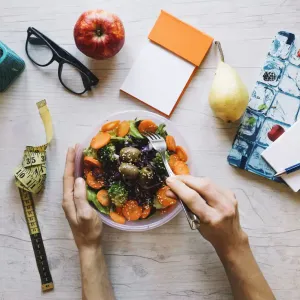

Our Review Process
Our articles undergo extensive medical review by board-certified practitioners to confirm that all factual inferences with respect to medical conditions, symptoms, treatments, and protocols are legitimate, canonical, and adhere to current guidelines and the latest discoveries. Read more.
Our Editorial Team
Shifa Fatima, MSc.
Author
Dr. Apoorva T, MHM.
MEDICAL ADVISOR
Is Tapioca Good for Diabetes?
Starch obtained from a tuber called Cassava root, native to South America, is used to produce tapioca. Tapioca is entirely made up of starch, with little nutritional benefits. Cassava root is a staple ingredient in various African, Asian, and South American cultures and is reasonably cultivable. It doesn't have gluten by nature, and thus it may be used as an alternative to wheat. But the question remains, is tapioca good for diabetics? It is thought to be!
Pressing starch juice from crushed cassava root differs by region, but it always includes pressing. After removing liquid starch, water will dissipate, and powdered tapioca remains. This powdered tapioca is later converted to the required form, like flakes.
Table of Contents
Glycemic Index of Tapioca
GI is a common term to you if you are a diabetes patient. The GI stands for – Glycemic Index. The Glycemic index is a numerical value attached to all food items, ranging from 0 – 100.
Tapioca's high GI of 70 and medium GL of 12.6 make it somewhat risky for people trying to maintain stable blood sugar levels.
Nutritional Value of Tapioca
Tapioca is used widely in Asian cultures. Over time, it has grown in popularity. Tapioca has the following nutritional values:
| Nutrients | Amount Present |
|---|---|
| Calcium | 20 mg |
| Iron | 1.6 mg |
| Protein | 0 g |
| Fat | 0 g |
| Carbohydrates | 26 g |
| Fibre | 0 g |
| Sugar | 0 g |
The above details have been given for a 1/4th serving of tapioca.
Health Benefits of Tapioca
- Tapioca is high in dietary fibre.
- The presence of fibre in your body aids in the proper functioning of the digestive system. It assists in appropriate digestion and delayed uptake of nutrients.
- Flour made from tapioca gets digested easily as compared to regular flours. It can also help with many digestive issues.
- Tapioca offers a lot of nutritious carbohydrates; thus, it helps gain weight. These carbohydrates can build up in the body, causing weight gain.
- Tapioca contains starch with resistive qualities that feed the bacteria present in your gut, thus improving intestinal and digestive functioning.
- The many perks tapioca has for digestive health is beneficial for colon health and may colon cancer.
- Tapioca acts as a high-energy meal that is frequently consumed during fasting periods.
- Tapioca helps the body absorb iron in larger amounts, which could help avoid anaemia, especially in women.
- Tapioca could help develop newborns' cognitive abilities and avoid congenital disabilities.
- Furthermore, tapioca intake is beneficial to nursing mothers since it provides fibre and starch, which will increase the production of breast milk.
- Tapioca flour is a healthier option because it is free of gluten, grains and nuts.
- Tapioca has next to no fat and has high fibre, which helps to decrease cholesterol levels. However, is tapioca good for diabetics? Yes, it is!
- Tapioca is effective against a headache and can even cure a migraine.
- Vitamin A present in tapioca is beneficial for eyesight and ageing eye disorders.
- Tapioca can treat problems related to the skin, such as dull skin, skin with scars and spots, rough skin, even dry skin, and hair difficulties.


Benefits of Tapioca for Diabetes
Altered starch of tapioca has the potential to reduce levels of insulin. Mice with diabetes on a high-fat diet were administered altered tapioca starch in an experiment. Insulin resistance seemed much reduced in tapioca starch-fed animals than in controlled ones. Further study is warranted to see if this is similarly observed in people who have diabetes.
Different Ways to Consume Tapioca for Diabetes
Sweet Balls made from Tapioca
Things you’ll need:
- Tapiocas (two)
- Coconut (grated and a quarter of a cup)
- Sugar (a quarter of a cup)
- Coconut (two tbsp and desiccated)
- Cardamom powder (one tbsp)
Procedure:
Peel the skin off your tapioca and expose the white underneath. Next, cook using a pressure cooker after adding a little salt. Then Pound them thoroughly. Combine the sugars, shredded coconut, and cardamom powders in a mixing bowl. Put small amounts of smashed tapioca and shape it into tiny balls, coating them equally with coconut (desiccated).
Tapioca Pudding
Things you’ll need:
- Milk powder (skimmed and eight tbsp)
- Tapioca flour (diluted with water and twelve tbsp)
- Water (warm and 600ml)
- Egg yolks (four)
- Sugar (eight tbsp)
- Egg white (six)
- Pistachios (chopped and four tbsp)
- Vanilla essence (one tbsp)
Procedure:
Put vanilla extract and milk powder in boiling water. Whisk in tapioca flour over low flame for 10 min. Then continue whisking using egg yolks this time, constantly stirring to prevent the development of skin. Using half the sugar, whip egg whites until stiff, then fold in the remaining sugar. Continue next by gradually folding meringue into heated tapioca and adding pistachios—Bake for 40 minutes at 190 degrees in a water bath.
Tapioca Upma
Things you’ll need:
- Oil (one tbsp)
- Urad dal (half tbsp)
- Tapioca (cooked and 250 g)
- Mustard seed (one tsp)
- Chilly (two green, split)
- Cumin seed (half tsp)
- Curry leaf (one spring)
- Coconut (grated and three tbsp)
- Salt
Procedure:
Using a large skillet, heat the oil, then add the seeds of mustard. Add seeds of cumin when they start popping along with urad dal, curry leaf, and sliced green chilli and for three minutes, cook them until aromatic. Tweak the salt as per your taste after adding the fried tapioca chunks. Combine all the components in a large mixing bowl. Cook, covered, using low flame for eight minutes while stirring periodically. Grate some coconut on top.
How to prepare?
Tapioca is the simplest carbohydrate to prepare by yourself.
Water and then cassava are the two things you'll need first. A pot is required, as well as spoons.
Let the cassava boil for twenty minutes after adding sufficient water to submerge it. Next, reduce the heat to keep it simmering but not to the point where it boils over. It will stop unwanted water evaporation.
Now, with fingers, probe around the mixture to see whether it's mushy and hence can be split smoothly; or else, keep cooking for a couple of extra mins. After that, please take a few forkfuls of the mix from within the saucepan and wash them with cold water. This should stop the process of cooking and make sure that the tapioca doesn't become sticky. Next, keep the cassava in cold water (washing is enough) for some minutes. It should be done according to the degree of hardness you want it to gain.
Again, is tapioca good for diabetics? It indeed is!
Bottomline
Tapioca is extremely high in carbohydrates. That is the only quality present in this food as it is low in minerals, vitamins, and any other important nutrient that is essential to maintain a balanced and healthy diet. ¼th serving of tapioca has 26 grams of carbs – which is significantly high. Even though it has 0 sugars, it is not recommended for a person with diabetes. This food has certain benefits that can make it advantageous – however, the costs might outweigh the benefits in the case of people living with diabetes. Consuming a very limited quantity of tapioca in infrequent intervals would be a good idea for people with type 1 or type 2 diabetes.
FAQs
1. Is boiled tapioca good for weight loss?
Tapioca contains zero protein and fat, yet studies show that these nutrients can help certain individuals who are dieting or exercising to lose weight.
2. Is Tapioca good for Blood Pressure?
Tapioca is frequently utilised to treat hypertension. It accomplishes this for a variety of reasons. Few are related to the presence of niacin. Tapioca contains niacin, which relaxes the muscles that affect blood channels to contract, lowering blood pressure.
3. Is tapioca gluten-free?
Whether your stomach is sensitive or is on a tight diet, you could still consume this fearlessly. Consuming the flour of tapioca does not appear to have any negative consequences!
References
- https://www.webmd.com/diet/tapioca-health-benefits-nutrition-uses
- https://www.healthline.com/nutrition/tapioca
Disclaimer
This website's content is provided only for educational reasons and is not meant to be a replacement for professional medical advice. Due to individual differences, the reader should contact their physician to decide whether the material is applicable to their case.








